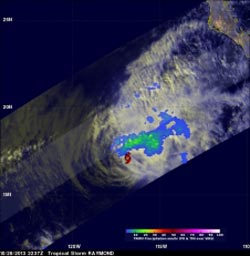NASA Sees Tropical Storm Raymond Fading Fast

The AIRS instrument aboard NASA's Aqua satellite captured infrared data on Tropical Depression 29W on Oct. 29 at 04:23 UTC/12:23 a.m. EDT and saw strong thunderstorms (purple) west and east of the center. <br>Image Credit: NASA JPL, Ed Olsen<br>
Raymond contained rainfall only in an area northwest of its center of circulation when the Tropical Rainfall Measuring Mission or TRMM satellite passed above on October 28, 2013 at 2337 UTC/4:37 p.m. PDT.
Rainfall data from TRMM's Microwave Imager (TMI) and Precipitation Radar (PR) were combined with a visible and infrared image from TRMM's Visible and InfraRed Scanner (VIRS) to provide an analysis of the storm. The analysis revealed that the maximum rainfall intensity associated with Raymond was only about 33.6mm/~1.3 inches per hour. The TRMM satellite is managed by NASA and JAXA.
The National Hurricane Center noted that Tropical Storm Raymond's maximum sustained winds were down to near 50 mph/85 kph on Oct. 29 at 11 a.m. EDT/1500 UTC. Raymond's center was located near latitude 18.3 north and longitude 116.9 west, about 555 miles/890 km southwest of the southern tip of Baja California, Mexico.
Raymond was moving slowly at 6 mph/9 kph, and is expected to slow more as it weakens over cooler waters tonight, Oct. 29. The NHC expects Raymond to become a remnant low in a day or so.
Text credit: Hal Pierce
SSAI/NASA's Goddard Space Flight Center
Media Contact
All latest news from the category: Earth Sciences
Earth Sciences (also referred to as Geosciences), which deals with basic issues surrounding our planet, plays a vital role in the area of energy and raw materials supply.
Earth Sciences comprises subjects such as geology, geography, geological informatics, paleontology, mineralogy, petrography, crystallography, geophysics, geodesy, glaciology, cartography, photogrammetry, meteorology and seismology, early-warning systems, earthquake research and polar research.
Newest articles

Detector for continuously monitoring toxic gases
The material could be made as a thin coating to analyze air quality in industrial or home settings over time. Most systems used to detect toxic gases in industrial or…

On the way for an active agent against hepatitis E
In order to infect an organ, viruses need the help of the host cells. “An effective approach is therefore to identify targets in the host that can be manipulated by…

A second chance for new antibiotic agent
Significant attempts 20 years ago… The study focused on the protein peptide deformylase (PDF). Involved in protein maturation processes in cells, PDF is essential for the survival of bacteria. However,…





















